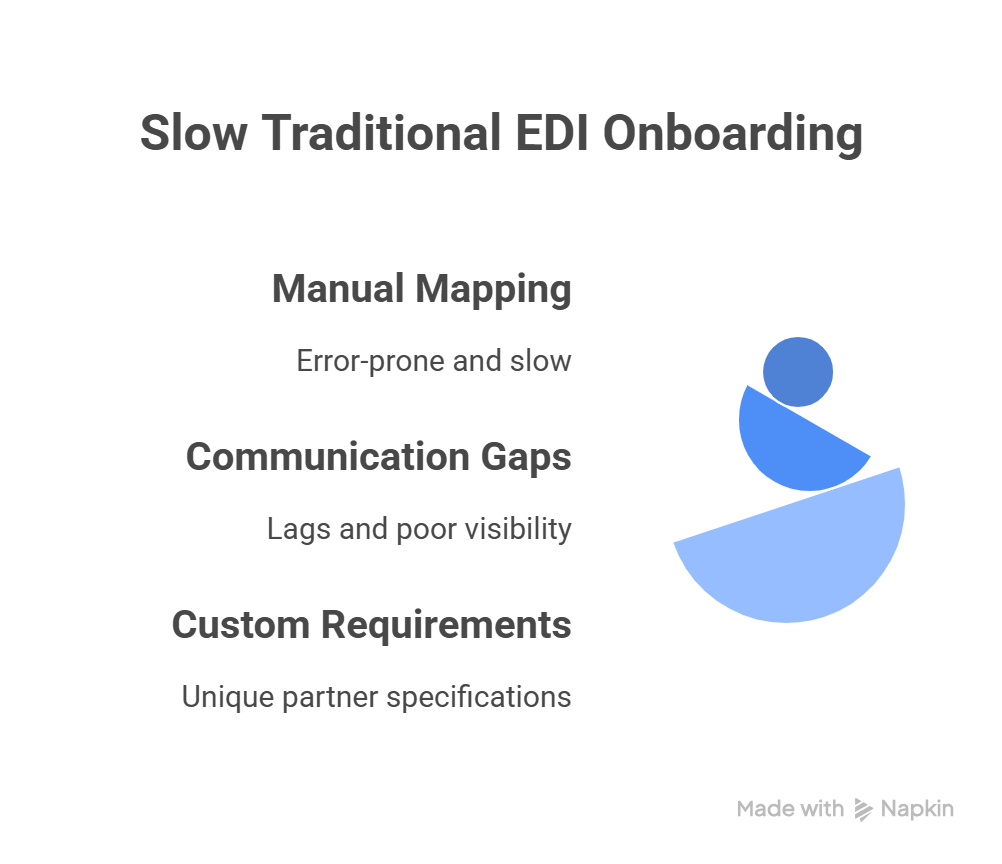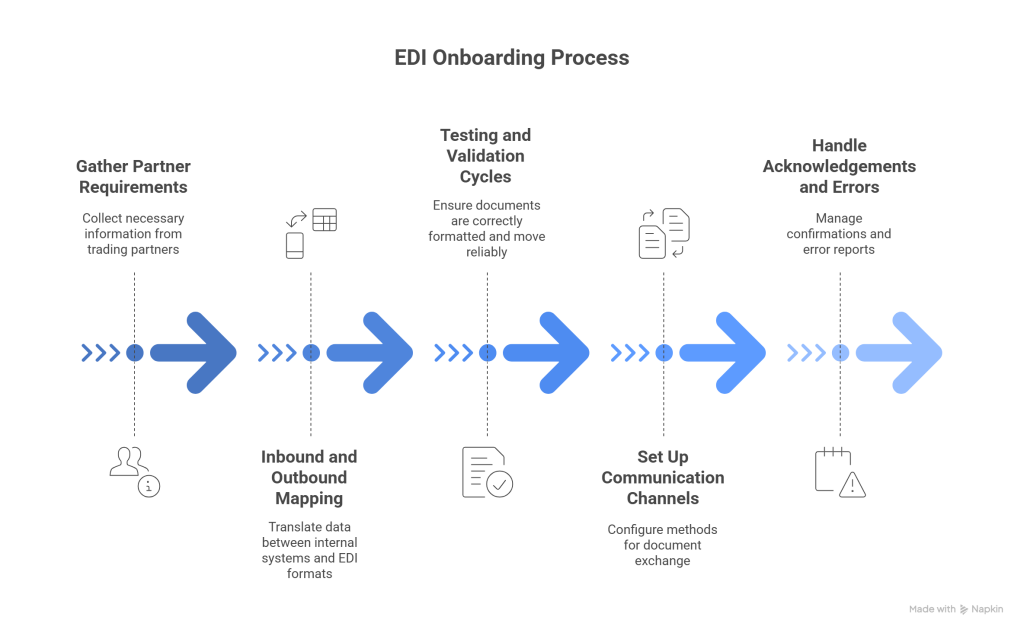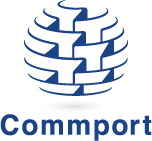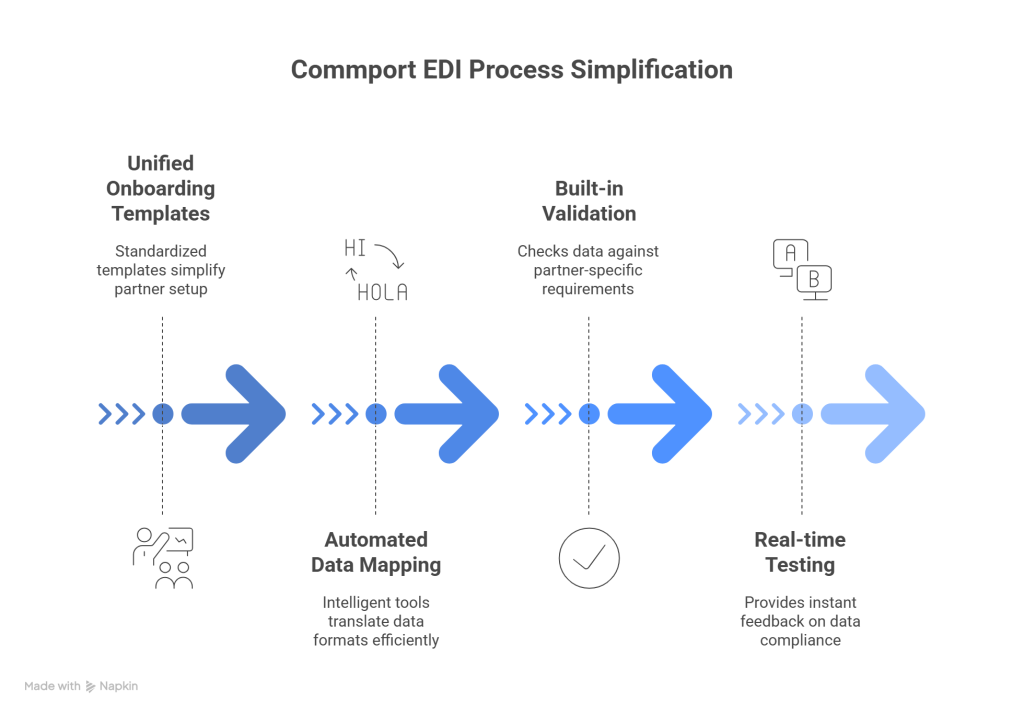Introduction
Most companies have simply accepted 8-10 week EDI onboarding times as normal.
Every extra day spent waiting to onboard a new partner means another day of lost revenue.
Meanwhile, your competitors might have the same supplier exchanging data within days while you’re still debugging translation errors.
We understand this challenge.
That’s why we at Commport Communications developed an EDI solution that transforms the EDI onboarding process through intelligent automation.
By streamlining and automating EDI processes, your business can get to market 80% faster.
In fact, our EDI platform has reduced EDI supplier onboarding from months to less than a week, all while ensuring 100% EDI compliance.
Key Takeaways
- Automation eliminates bottlenecks: Automated mapping, real-time validation, and unified templates remove manual delays that plague traditional EDI implementations.
- Speed drives revenue: Companies can start processing orders and generating revenue almost immediately after retail placement instead of waiting months.
- Partner satisfaction improves: Quick, reliable onboarding builds stronger trading relationships and positions your company as a dependable supplier.
- Costs decrease significantly: Electronic processing saves $50+ per document while reducing manual data entry, printing, and storage expenses.
- Scalability enables growth: Modern EDI platforms allow businesses to onboard multiple partners simultaneously without operational disruption.
Why Traditional EDI Onboarding Takes So Long

Traditional EDI onboarding should take 1-2 weeks in theory, but the reality is starkly different. Most companies face delays stretching to 1-2 months or even longer. These extended timeframes aren’t happening because organizations lack motivation—they stem from outdated systems and processes that weren’t designed for speed or flexibility. Let’s examine the key factors causing these significant delays.
1. Manual Mapping and Validation Delays
The traditional EDI onboarding process remains heavily dependent on human intervention, creating bottlenecks at nearly every step. From document creation to data mapping, many workflows still rely on spreadsheets, email threads, and manual handoffs. These labor-intensive methods introduce several problems:
- Error-prone validation: Many EDI formats, particularly older ones like EDIFACT, weren’t designed for human readability. This makes catching and fixing errors exceptionally challenging, requiring specialized (and increasingly rare) skill sets.
- Time-consuming testing: The most intensive part of EDI onboarding is testing and validation. Each document must be validated in a specific order defined by your trading partner. When transactions are invalid, you must re-engage developers to make changes before trying again—a back-and-forth process that can consume weeks of development time.
- Resource limitations: EDI responsibilities are frequently assigned to departments where they aren’t the primary focus. With competing priorities, EDI tasks often take a backseat, creating substantial delays.
Manual error detection remains both expensive and inefficient, yet continues to be common practice. Even when human verification is possible, the process is tedious and still prone to mistakes that can lead to transaction failures downstream.
2. Lack of Real-Time Communication
Traditional EDI onboarding suffers from communication gaps that compound delays. The process is driven by humans with feedback loops that aren’t in real-time. This creates several challenges:
Internal teams often find themselves waiting on responses from trading partners, IT staff, or external EDI providers. These communication lags multiply quickly, especially when juggling multiple partner connections simultaneously.
Without centralized visibility, tracking onboarding progress becomes difficult. Teams waste valuable time emailing for status updates or losing track of stalled processes. Moreover, poor visibility across document flows prevents teams from proactively identifying and resolving issues.
The absence of monitoring during off-hours further exacerbates these communication problems. Without dedicated personnel overseeing systems during nights, weekends, or holidays, critical updates may be missed, and issues can accumulate unnoticed.
3. Custom Requirements for Each Partner
Perhaps the most significant factor slowing EDI onboarding is the unique nature of each trading relationship. Every partner has distinctive requirements that necessitate custom configurations:
Each trading partner defines their own guidelines for EDI transactions, including content, structure, and transmission methods. These specifications dictate how you’ll integrate with each partner and are guaranteed to be unique.
Beyond standard differences, partners often have specific needs regarding file types, data formats, and communication protocols. Some might require AS2, while others prefer SFTP or VANs. Although you might use identical technology across partners, each connection requires a unique configuration.
Most EDI tools don’t validate data against partner-specific guidelines but instead compare against generic EDI specifications. This mismatch between actual requirements and validation capabilities leads to extensive testing cycles and frequent rework.
Legacy EDI systems further complicate matters with their rigid, on-premise infrastructure. These outdated platforms often require complex configurations, custom code, or third-party connectors for each new integration. Without a centralized platform, internal teams must build patchwork environments to support onboarding—leading to inconsistent results and extended timelines.
Breaking Down the EDI Onboarding Process
The EDI onboarding process follows a structured pathway that, when broken down into its parts, becomes easier to understand and optimize. Let’s examine each step of this critical business process that connects your organization with trading partners.

1. Gathering partner requirements
The foundation of successful EDI onboarding begins with collecting comprehensive information from your trading partner. This initial step involves identifying specific EDI requirements, including supported file formats, communication protocols, and security requirements. You’ll need to establish clear communication channels with your partner’s EDI team to ensure smooth information exchange throughout the process.
Essential elements to gather include:
- EDI IDs for both organizations (ISA IDs, ISA Qualifiers, Application Codes)
- Transaction types you’ll exchange (purchase orders, invoices, etc.)
- Implementation guides or requirements documentation
- Timeline expectations and deadline constraints
Without thorough requirements gathering, organizations risk creating mappings that don’t align with partner expectations, leading to failed transmissions and extended onboarding timelines.
2. Inbound and outbound mapping
Mapping is the technical core of EDI implementation, creating the translation layer between your internal systems and standardized EDI formats. Inbound maps process incoming EDI documents into your system, while outbound maps transform your data into EDI format for transmission.
For inbound mapping, the system translates partner EDI documents into formats compatible with your internal applications. Outbound mapping is more complex as it requires coordination of partner-specific information like ID numbers, enveloping specifications, and control numbers.
Many organizations leverage template maps to accelerate implementation, particularly for common document types. This approach helps standardize mapping processes and reduces implementation time across multiple partners.
3. Testing and validation cycles
Testing forms the foundation of reliable EDI operations, ensuring documents are correctly formatted and move reliably between systems. Effective EDI testing validates that transactions meet both industry standards and partner-specific requirements before any live exchange occurs.
A comprehensive test plan typically includes:
- Unit testing (focusing on individual transactions)
- Integration testing (verifying seamless movement between systems)
- Compliance testing (ensuring documents meet standards like ANSI X12)
- Certification testing (proving your ability to exchange reliably with specific partners)
Certification testing can significantly impact implementation timelines, as each trading partner may require separate certification cycles that take weeks without automation.
4. Setting up communication channels
Communication methods determine how EDI documents physically move between organizations. Common options include direct connections like SFTP/FTPS, AS2 protocol, or Value-Added Networks (VANs).
The chosen communication method must be configured for both inbound (receiving documents from partners) and outbound (sending documents to partners) transmissions. For many organizations, using a third-party VAN service simplifies this process by providing a single connection point while handling protocol translations between partners.
5. Handling acknowledgements and errors
The final component involves establishing mechanisms for acknowledgment handling and error management. EDI systems generate acknowledgments like TA1 (interchange acknowledgment) and 997/999 (functional acknowledgment) to confirm receipt and report errors.
These acknowledgments serve as electronic receipts, confirming whether transmitted documents were accepted, accepted with errors, or rejected. A robust EDI system must be configured to both send acknowledgments for received documents and process acknowledgments from partners for your transmissions.
Proper error handling ensures that problems are identified promptly, enabling quick resolution and preventing disruption to business processes. Without automated acknowledgment handling, organizations must manually verify document receipt, significantly increasing administrative overhead.
How Commport EDI Simplifies Each Step

Commport EDI stands out in the industry by taking what’s typically a lengthy, complex process and transforming it into a streamlined, efficient operation. Our approach tackles each traditional pain point head-on through powerful automation and intelligent design.

1. Unified Onboarding Templates
Setting up new trading partners no longer requires starting from scratch each time. We’ve developed standardized onboarding templates that dramatically simplify the initial setup process. These templates act as ready-made blueprints for common EDI scenarios, eliminating the need to recreate documentation for each new connection.
Our platform provides document templates that can be quickly customized for specific partner requirements, serving as consistent frameworks that accelerate implementation. By standardizing the initial gathering phase, we’ve eliminated a significant source of delay that plagues traditional approaches.
2. Automated Data Mapping and Transformation
Data mapping traditionally consumes the most time in EDI implementations, yet it’s precisely where Commport EDI excels. Our system employs sophisticated mapping tools that translate data formats between your system and trading partners automatically, ensuring data flows smoothly and is interpreted correctly on both ends.
The platform leverages intelligent algorithms to map data accurately and efficiently, reducing what would typically take days to mere hours. This automation minimizes manual data entry, cutting labor costs considerably while boosting data quality through consistent transformation rules.
3. Built-in Validation Against Partner Specs
Perhaps the most valuable feature in our toolkit is built-in validation against partner-specific requirements. Unlike generic EDI systems that only check against standard EDI formats, Commport EDI validates documents against your trading partner’s exact specifications.
Our platform runs EDI compliance checks to ensure data quality and validity before messages leave your system. This proactive approach catches errors early, preventing costly technical issues that would otherwise require manual intervention to correct. The system automatically flags non-compliant data, allowing for immediate corrections without lengthy back-and-forth communications.
4. Real-Time Testing and Feedback
Traditional EDI onboarding suffers from extended waiting periods between test cycles. Commport EDI eliminates this bottleneck through real-time testing capabilities that provide instant feedback on data compliance. This immediate validation allows for quick corrections, dramatically shortening the testing phase.
The platform offers detailed error messages with field highlights and direct navigation to problem areas, making corrections faster and more intuitive. This real-time approach accelerates the entire certification process that traditionally takes weeks to complete.
EDI onboarding made easy. Switch to Commport EDI today and reduce your onboarding time from months to days.
Accelerated EDI Onboarding in Action: Hologic Case Study
Numbers tell the real story when it comes to EDI onboarding efficiency. Real businesses are experiencing dramatic improvements with modern EDI solutions, turning theoretical advantages into measurable business outcomes.
Case study: Reducing onboarding from 8 weeks to 5 days
Most companies have accepted 8-10 week EDI onboarding timeframes as unavoidable, yet this assumption is increasingly outdated. Commport’s cloud EDI platform has demonstrably reduced implementation times by 80%, with many clients completing their entire EDI integration in less than 5 days rather than months.
Hologic’s experience serves as a prime example. After selecting Commport’s EDI solution, they received a dedicated Customer Success Manager who guided them through each integration step. Their entire implementation was completed in just weeks—a remarkable improvement from previous technology timelines.
The results were immediate:
- Orders previously taking 1-3 business days are now processed same-day
- Manual interventions reduced from 3-4 touches per order to minimal oversight
- Stronger trading partner relationships through more reliable processing
How Commport handles multiple trading partners at once
A key advantage of Commport’s approach is its vast network of pre-established connections across industries. This foundation allows businesses to quickly establish new EDI relationships without starting from scratch each time.
For companies managing complex supply chains, Commport offers streamlined processes, including tools for mapping, testing, and validating multiple connections simultaneously. Their platform includes ongoing partner management capabilities that continuously monitor connection status, troubleshoot issues, and ensure compliance with changing requirements—ensuring relationships remain stable after initial setup.
Business Benefits of Faster EDI Onboarding
The business impact of accelerated EDI onboarding extends far beyond technical efficiency, delivering tangible advantages that directly affect your bottom line.
1. Faster Time to Revenue
Rapid EDI onboarding directly accelerates revenue generation. When supplier connections that traditionally took months are completed in days, products reach store shelves or ecommerce catalogs sooner—capturing sales before competitors can catch up. Consequently, businesses experience improved cash flow as they can start processing purchase orders, generating invoices, and booking sales almost immediately after winning retail placement.
2. Improved Partner Satisfaction
Quick, reliable onboarding builds stronger business relationships. Trading partners favor suppliers who demonstrate reliability and readiness without routine errors or delays. Furthermore, this efficiency supports smoother order fulfillment with fewer costly disputes. As a result, businesses that complete EDI onboarding in days rather than weeks earn a reputation for dependability that opens doors to additional opportunities.
3. Reduced Operational Costs
Automated EDI processes yield substantial cost reductions across multiple areas. Organizations can save up to USD 50.00 or more per document by transitioning to electronic formats. Additionally, consolidated onboarding eliminates bottlenecks, leading to faster transaction times and fewer errors. These improvements translate into lower operational costs through reduced manual data entry, eliminated printing and mailing expenses, and decreased storage requirements.
4. Scalable Onboarding for Future Growth
EDI scalability enables businesses to expand efficiently by quickly onboarding new partners and adapting to changing demands. This flexibility allows organizations to integrate with various systems and technologies, ensuring long-term growth. Commport is North America’s top-rated EDI provider with over 6000+ customers, offering a solution that can support many retailers at once without slowing down—essential for companies expanding into new markets.
Conclusion
EDI onboarding doesn’t need to be a months-long ordeal that delays revenue and frustrates trading partners. Through intelligent automation and cloud-based architecture, Commport EDI has transformed what was once an 8-10 week process into a streamlined implementation taking less than 5 days.
The evidence clearly demonstrates how automated mapping, real-time validation against partner specifications, and unified templates eliminate the traditional bottlenecks that have plagued EDI onboarding for years. Companies partnering with Commport experience significantly faster time to market, processing orders same-day rather than waiting days for manual intervention.
Most importantly, this accelerated approach delivers tangible business outcomes beyond technical efficiency. Your company can begin generating revenue almost immediately after winning retail placement. Your trading partners will appreciate your reliability and readiness. Your operational costs will decrease through reduced manual processing and fewer errors.
The days of accepting lengthy EDI onboarding as “normal” are behind us. Modern solutions now make it possible to scale your business efficiently, adding new partners in days instead of months. Consider how much revenue you’re leaving on the table with traditional implementation methods. After all, while you’re still debugging translation errors, your competitors might already be processing orders and building stronger partnerships.
Therefore, the question becomes not whether you can afford to accelerate your EDI onboarding, but whether you can afford not to.
Commport EDI Solutions - Affordable and Quick Onboading
Need Help? Download: Commport's EDI Buyers Guide
Unlock the full potential of your supply chain with our comprehensive EDI Buyer's Guide — your first step towards seamless, efficient, and error-free transactions
Frequently Asked Questions
EDI onboarding is the process of setting up electronic data interchange connections with trading partners. It’s crucial for businesses as it enables faster, more accurate exchange of business documents, leading to improved efficiency and reduced operational costs.
Traditional EDI onboarding usually takes 1-2 months or longer. This extended timeline is often due to manual processes, communication delays, and the need for custom configurations for each trading partner.
How does Commport EDI accelerate the onboarding process?
Faster EDI onboarding leads to quicker time to revenue, improved partner satisfaction, reduced operational costs, and scalable growth. It allows businesses to start processing orders and generating revenue almost immediately after winning retail placement.
Automated EDI validation checks documents against partner-specific requirements in real-time, catching errors early and preventing costly technical issues. This proactive approach significantly reduces the time spent on testing and corrections, accelerating the entire onboarding process.





